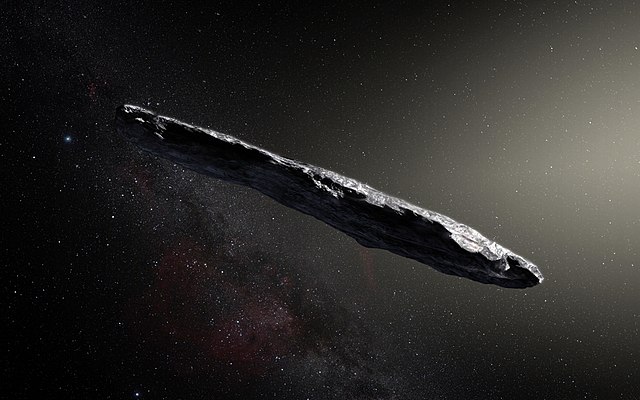"Alien ship" from another star system was covered with organic ice cobbles

In November of this year, Geektimes reported that an interstellar object was discovered in the solar system for the first time in history. This is interesting to itself, but the space wanderer has attracted attention also due to its shape. It is a highly elongated ellipsoid with a length to thickness ratio of 10: 1. As previously reported, the rotation period of the object is a little over 7 hours.
When checking the spectrum of the guest of the Solar System, it turned out that it is not much different from the usual for the cometary core of the spectrum. Well, of course, if you do not take into account the fact that U1 (Oumuamua) is not a comet at all, but it is not clear what. Among other interesting things, it was found that the brightness of the object is variable, and the albedo of different parts of the surface is slightly different.
According to experts, such guests are not so rare. Within a radius of 1 AE from the Sun at any given time, there can be a similar object with a size of up to 250 meters across. True, they are practically impossible to detect, since it is very difficult to implement technically. If a group of asteroids can be detected with the help of modern technical means, then one asteroid at such a distance is almost imperceptible. The “guest” himself was found almost by accident. Initially, it was considered an asteroid with an eccentricity estimate of about 0.5. Then he was lost and found again. The second time, it became clear that the “asteroid” was rather strange, its classification was changed to “comet-like” with an eccentricity of 0.997. And only then it became clear that the trajectory of the object (which, by the way, was called Oumuamua) is hyperbolic.
On the origin of the object put forward a variety of hypotheses. One of them said that an asteroid could be lost control of an interstellar alien spacecraft from a distant star (in fact, such an assumption has a right to exist, because the Universe is huge, why would there not be a highly developed interplanetary civilization?). By the way, in order to still find out the details of the asteroid's structure, its origin and other factors, on December 13, astronomers of the American Observatory Greenbank began to “listen” to the guest in four frequency ranges at once, from 1 to 12 gigahertz. The first phase of observation with a duration of 10 hours is divided into 4 intervals, which are selected in full accordance with the period of rotation of the asteroid. Currently, Oumuamua are 70 closer to Earth than Voyager 1. The power of a radio telescope with a mirror diameter of 100 meters is so high that it can detect the operation of any weak transmitter, whose power is comparable to a cell phone.
Now scientists are more inclined to believe that the object is of natural origin, and it is an elongated piece of ice covered with a thick layer of organic matter. And just this layer protects the water ice of the asteroid from evaporation under the action of the rays of the sun.

This view is facilitated by the observation of the asteroid with the help of ground-based observatories around the world. A team of scientists led by Alan Fitzsimmons conducted a thorough analysis of the asteroid spectra obtained in the visible and near infrared regions of the electromagnetic spectrum (wavelengths, respectively, from 0.3 to 1.8 μm). Observations helped clarify a bit the composition of the surface layer.
As it turned out, the organic “crust” has a reddish tint, which suggests a relatively large concentration of tolines, which are formed when cosmic rays are exposed to ice, which contains the simplest organic compounds. This is not news, Pluto’s surface is rich in some areas of the dwarf planet. Plus, the color of the asteroid allows you to talk about his age. The fact is that for the formation of a reddish shade of organic substances on the surface of a space object, at least 10 million years is necessary.
The surface layer of the asteroid is rather thick - 30–40 meters. At this depth there is almost no water ice, solid organic. But the inner layers of the asteroid are rich in water ice, no doubt about it. And this ice is strong enough not to collapse under the influence of forces generated during the rotation of the asteroid around its axis.
By the way, now Earth scientists have plans to create a spacecraft that is able to catch up with the asteroid in order to study it. It is, first of all, about the project "Lira" .
All Articles